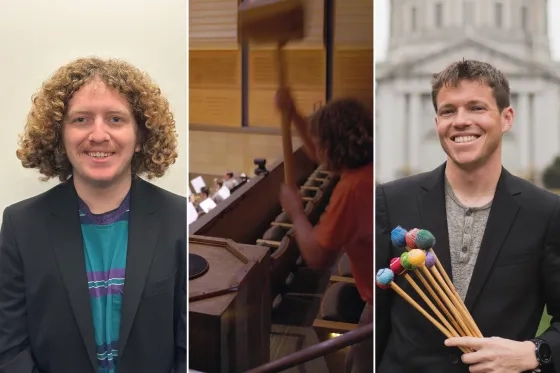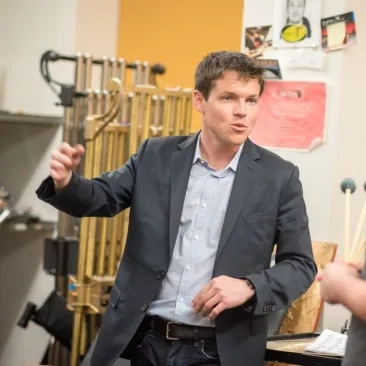'The Holy Grail of Percussion:' SFCM Percussionists Discuss the Famous Mahler ‘Hammer Smashes’
Percussion student Brandon Topolski and his teacher Jacob Nissly talk about the joys of playing a symphony that ends with a series of impacts from a giant hammer.
Although Tchaikovsky’s infamous cannon shots from his 1812 Overture are louder, there are few other joys a concert percussionist can have that compare to the climactic hammer smashes at the end of Gustav Mahler’s Symphony No. 6.
“This is like the holy grail of percussion,” 2025 grad Brandon Topolski says. “It's just one of the coolest things.” His teacher, San Francisco Symphony (SFS) Principal Percussionist Jacob Nissly, agrees: “These are moments that you go into percussion for, knowing that you're going to have them thrown your way. And you typically seek them out.”
Mahler in his original score called for the sound of the hammer blows to be “brief and mighty, but dull in resonance and with a non-metallic character—like the fall of an axe.” It was something of a controversy in its day: A German humor magazine, Die Muskete, put a caricature of Mahler on its cover in January 1907 after the symphony’s premiere six months prior. The caption of the cartoon—showing Mahler surrounded by various unorthodox percussion instruments—reads, "My God, I forgot the car horn! Now I can write another symphony."
The actual tools of performance have changed as well. “It started out way smaller and then they found that since the symphony is just so gigantic with orchestration and sound, they needed something that would actually cut through the orchestra,” Topolski explains. The need for volume necessitated the construction of a box made to both withstand the hits and actually amplify them. The one Topolski used in the May performance of the symphony with the SFCM Orchestra was rented from the SFS, custom made by a former bassist of the Chicago Symphony with a woodworking hobby.
“He just made them a box specifically for this, Topolski says. “It is just a giant box, obviously, and there’s a strike pad. So the whole thing compresses when you hit it, and there are two little cuts where that air exits. It weighs about 85 pounds, whereas the hammer itself is closer to 20.”
Nissly adds that he always tells his students, “Out of all the things I've done, the hammer blows still feel like the most nerve-wracking thing I ever do, because it's the one thing that everyone on the planet will know if you don’t do it correctly.” Nissly continues, “Being a percussionist is a lot like being a fireman: A lot of the time you're sitting around not doing a whole lot, and then all of a sudden, there’s crazy stress you’re under for 20 seconds or whatever.”
“When I play this part at the San Francisco Symphony, the way we've done it, it's been up in the choir loft and I have to leave the stage,” Nissly continues. “But then once I walk out to the box in the choir terrace behind the orchestra, which is empty, I know, people are like, ‘What is going on here?’ It can be hard in those moments to stay focused, because you have this spell where you're just enjoying the orchestra from one of the best seats in the house. Every time I've had the fortune to do it, it's a huge adrenaline rush, a huge thrill.”
Nissly and Topolski are both united against one other controversial aspect of the Mahler hammer: The practice of sometimes dusting the striking box with baby powder to add more visual flair to the hits. “We haven't done that one at the Symphony,” Nissly said. “I don't think my colleagues would appreciate that, because the way it's situated, it would just rain down on them.”
Learn more about the SFCM Orchestra or about studying Percussion at SFCM.


